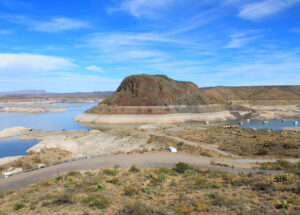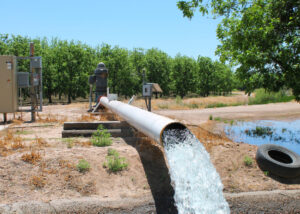Elephant Butte Irrigation District (EBID), which services over 6,700 farm members across a service area of 90,640 acres, has stewarded the surface water of New Mexico’s portion of the Rio Grande Project (RGP) for over 100 years. Its water deliveries are complicated by several factors, including delivery obligations under the 1906 Convention Treaty with Mexico, the 1902 authorization of the RGP as a Bureau of Reclamation project, and the formulation of the 1938 Rio Grande Compact Commission—plus a drought that has lasted now for 19 years. In this interview, EBID Treasurer/Manager Gary Esslinger tells Irrigation Leader about how the district is adapting to these institutional demands and trying climatic circumstances.
Irrigation Leader: Please tell us about yourself and about EBID.
Gary Esslinger: I grew up on a family farm in southern New Mexico, where my grandfather settled and started farming in 1912. In 1978, I began working for EBID. I have held various positions as I have climbed the ladder within the organization, and in 1987, I was appointed to the position of treasurer/manager by the board of directors. I have remained in that position for the last 33 years. Our district has 90,640 acres of irrigable land within the RGP in south-central New Mexico, and we service over 6,700 farm members with our 300 miles of canals and 600 miles of drains. We have been blessed to serve the farmers of the Rincon and Mesilla Valleys for 100 years now, and over that time we have become an extension of their farming operations and play a role in promoting the agricultural economy of the state, which is known for its famous chiles, pecans, and onions.
Irrigation Leader: Would you tell us about the history of drought in your district?

Gary Esslinger: As a farm boy growing up during the 1950s and 1960s, I helped my dad as we experienced the worst drought on record in the RGP. I began working for EBID in 1978, when the farmers were dealing with another drought; that year, they were allotted only 8 acre-inches. I was fortunate to be a part of EBID when we were blessed with 23 years of full water supply and every farm was getting 3 acre-feet per acre a year, even 4½–5 acre-feet if they could take it. There was water everywhere—millions more acre-feet than we could store with the infrastructure we had then.
In 1999, I began to see that the Elephant Butte and Caballo Reservoirs were not filling up every year from snowmelt runoff as before, and by 2003, we had hardly any water in storage to deliver to the farms. It has been 18 years, and we are still reeling from this drought. It has broken the records of droughts from the 1950s, 1960s, and 1970s. It is approaching the severity of the droughts from the 1930s, during the Dust Bowl era.
Today, EBID is concentrating on what it needs to address this drought as we prepare for the uncertainty of the future. We are instituting and initiating programs based on our planning needs. New Mexico is developing a 50‑year water plan. In our district, we’ve already met many of the planning goals it lays out; however, we have to be able to do more with less and make changes to address the current needs of the farmers within EBID. Someone once said, “Affairs of the state make for grand design, but in the end the things that matter most happen on the streets where we live.”
Irrigation Leader: Is EBID looking for alternative water sources to help combat this drought?
Gary Esslinger: Right now, we have several alternatives in place, and we are working on issues including watershed management, storm water capture, brackish water development, and groundwater resource management.
We’re also doing everything we can to conserve water and to be more efficient with our surface and groundwater, including piping our laterals and automating, metering, and monitoring both surface and groundwater deliveries so that every drop is accounted for. Over time, our farmers have become efficient in how they conjunctively manage surface and groundwater on their lands, which in turn gives them better yields. They use drip irrigation, laser leveling, and other methods to concentrate water in the root zones of their plants. EBID complements their on-farm practices with our state-of-the-art SCADA and software technology.
The combined efforts of EBID and the farmers have helped us all survive the current drought. Farmers have voluntarily begun fallowing farm portions of their land in these times of drought and have used EBID’s water transfer process to move the water to more productive land. Through our land and water records department, we make these transfers happen daily and have been doing so for the last 40 years.
Irrigation Leader: What role do those users play in EBID’s board and governance?
Gary Esslinger: We have a nine-member elected board and 6,500–8,000 members. Over time, those members repaid the United States for the construction of Elephant Butte and Caballo Reservoirs, their dams, their diversion dams, and all the appurtenances. We’re proud of the fact that the handful of pioneer farmers who put their blood, sweat, and tears into the land were the ones who paid this project off. The public isn’t aware of that, and right now we’re under a lot of pressure from environmentalists, recreationalists, and others who would like to see the water used in the RGP for purposes other than agriculture. The RGP is unique in being a single-purpose Reclamation project built for agricultural purposes only. We’re carrying on a tough battle right now to defend what farmers within the RGP—not the public taxpayers—have paid for over the course of 100 years and to try to explain the institutional foundations that obligate EBID to deliver project water downstream to Texas and Mexico. The EBID board of directors sets the policies that administer the way we do business in order to keep up with a changing climate and hydrology and the calls of competing interests to use the water for uses other than agriculture.
Irrigation Leader: Is EBID allotted a set amount of water every year through the Rio Grande Compact?
Gary Esslinger: It is not the Rio Grande Compact that sets the amount of water allotted for EBID. Let me try to explain the three institutional foundations that are set in stone and that determine the allotment. First and foremost, the RGP was built to settle a treaty obligation with Mexico. People don’t realize that over 100 years ago, the United States was diverting Mexico’s fair share of the surface water in the Rio Grande upstream in Colorado and New Mexico and that this caused an international incident. The 1906 convention treaty settled the dispute with Mexico and guaranteed a 60,000 acre-foot delivery to the headgates of the Mexican canal near Juarez, Mexico, in perpetuity with safeguards for times of drought. There are similar treaties with Mexico that govern deliveries on the Colorado River and the Rio Conches as well; all have delivery obligations and safeguards for times of drought.
Second, after the United States Reclamation Service (now the Bureau of Reclamation) decided to build the RGP, it finally worked out plans to build storage facilities in New Mexico, 110 river-miles north of the border with Mexico, to guarantee its ability to deliver surface water to EBID; the El Paso County Water Improvement District No. 1 (EPCWID#1), a Texas irrigation district; and Mexico. The United States would then apply Reclamation law in developing rules that would set the allocation of water in storage to be released and delivered to the downstream users. To answer your question, it is the RGP, not the Rio Grande Compact, that determines the allocation, and it is the two irrigation districts in the United States and Mexico that determine the allotment that can be delivered based on irrigated acres for any given year.
Third, even after the RGP was completed in 1916, there was still conflict among the three states through which the Rio Grande runs—Colorado, New Mexico, and Texas—about how to account for the water entering and leaving each state and about how the surface water was to be divided. In 1938, the federal Rio Grande Compact was authorized by the three states. What complicates the compact is the delivery points at the state lines of each state. The most incongruous fact is that Elephant Butte Reservoir is the state line delivery point for Texas, even though the facility sits in geographic New Mexico. The most obvious reason for this is that Elephant Butte Dam is the only mainstem dam in this part of the Rio Grande and has the obligation to deliver surface water to the downstream users and Mexico.
It’s a constant battle to educate politicians, the public, and other agencies in our state about this history. I’ve gone through nine state engineers during my time here, and not all of them understand the unique setting of EBID within the state of New Mexico and the complexity of the other institutional frameworks involved. It is no surprise to me that we are back in the U.S. Supreme Court again over water matters. The federal agencies have changed over time as well, and new agencies have come in. One of the agencies that came in during the 1930s was the International Boundary and Water Commission. You would think that agency would have authority and jurisdiction over the entire international border between the United States and Mexico, from Tijuana to Brownsville, but the boundaries of its authority take a 60‑kilometer dogleg up into New Mexico to the Caballo Reservoir so that the RGP can ensure that the river delivers the proper amount of water to Ciudad Juarez, Mexico.
People think we should have water in the river all year round for natural and recreational purposes. The fact of the matter is that the Rio Grande dries up in the winter because the two irrigation districts and Mexico do not call for their water at that point. That is because it is harvest time and there is no reason to release water from the reservoir. Remember, the RGP was built for a single purpose: agricultural irrigation. When people drive along the Rio Grande, they see that in Colorado and northern New Mexico, the waters are pristine and clear. In the middle Rio Grande, they see the bosques and acequias and the way that the Pueblo tribes use their water. When they come down to the valleys below the reservoirs, the river is dry all winter, and even longer than that now, since this drought is making our irrigation season shorter. The Rio Grande doesn’t get wet again until you get to Del Rio, Texas. You can imagine the confusion and negative publicity it brings when people come into our area looking for the mighty Rio Grande and instead set their eyes on a bed of dry sand.

Irrigation Leader: Is your district in competition with towns and cities that are growing for water resources?
Gary Esslinger: Yes and no. EBID delivers surface water for agricultural purposes only, and there are no municipal surface water treatment plants in our area to which we would deliver surface water for potable treatment. Unfortunately, due to the drought, there is no guarantee of a certain amount of surface water coming through our system to recharge our aquifer, and we are all depending more on groundwater supplies. This in its self plays right into the hands of competing uses and how we manage our groundwater resource in our area. In El Paso, 40 miles south of us, 50 percent of the river water that goes to the EPWCID#1 is used by the City of El Paso for its drinking supply. The El Paso utilities have three surface water treatment plants. The City of Las Cruces, New Mexico, may consider a surface water treatment plant in the future; that is something that was discussed in the late 1990s and early 2000s, when there was plenty of water in storage. We worked hand-in-hand with the city to look at that possibility, but then the drought set in.
Irrigation Leader: Why does El Paso have more surface water treatment plants than your area?
Gary Esslinger: El Paso serves a population of about 900,000 people living in West Texas. El Paso had been planning since the early 1980s to acquire more water, and when it attempted to pump groundwater from New Mexico, it caused an ugly lawsuit. Those attempts were aggressive and were opposed by the State of New Mexico, EBID, and other New Mexico interests. After losing those fights, the El Paso utilities began to work closely with the EPWCID#1, its irrigation district, and began developing plans to build more surface water treatment plants and to acquire more water from its own farming constituents.
Since that happened, El Paso has acquired more and more formerly irrigated farmland and has converted that water to urban use. It has also developed brackish water supplies in El Paso and bought water farms 200 miles away, with plans to eventually pipe that water into El Paso. The City of El Paso has been doing aggressive water planning for the last 30 years, and it’s paying off. The city is acquiring and using different sources of water. In New Mexico, we have different laws and constraints that make it more difficult to do those things. That’s one reason that you see more water sources being used in El Paso than you see here, just 40 miles up the road.
Irrigation Leader: Is it more difficult for farmers to sell their water rights to cities in New Mexico?
Gary Esslinger: That can happen, but it is rare, because farming is still economically viable in this region. Every drop of water EBID uses goes to productive agriculture.
Irrigation Leader: What are the expected conditions for 2021?
Gary Esslinger: I have three words for what 2021 will be: dry, dry, dry. I’ve seen history repeat itself, and I’ve been here long enough to know that this drought is to be expected when you look at the hydrograph in this region over time. I am concerned that the hydrology in our watersheds is changing. Warmer winters, later snowpack runoff, and the fluctuation of our monsoon season make it harder to plan and predict.
We may have less than 6 inches of water for our farmers this coming irrigation season. We are getting a little bit of snow from the La Niña events, and we hope to get more snow in March and April when it usually comes to our part of the country.
Elephant Butte Reservoir holds over 2 million acre-feet of water; today, it’s 13 percent full. Caballo Reservoir holds over 200,000 acre-feet before it goes into flood storage, and it is 7 percent full. Those are the two storage reservoirs in southern New Mexico. Combined, they have only 166,000 acre-feet. We hope that by the time we start our irrigation season, we’ll have over 200,000 acre-feet, since some water will be sent down from the northern reservoirs that have to empty under compact rules. Normally, we can deliver water to our farmers in February and March, but this year, I don’t believe that we will send water to our farmers until about June 1. For now, they will have to rely on groundwater and use what little bit of surface water we can give them. They’ll probably have to use groundwater again at the end of the season. That is expensive for the farmers.
Conditions are changing every day, and as a manager, I work with my staff and employees to address those changes and deliver as much surface water as possible, whether it’s 6 inches or 3 feet. Even if the farmers must use groundwater, they still use our canal system to move the water around. My management goal is to be ready for whatever changes come our way. Now that we’ve been in drought for 19 years, we’ve got a pretty good management scheme under which we operate. If we get an abundance of water this year in a late snowpack event, we will adjust to a more robust system for managing the surface water. I still have an obligation to send water to Texas and Mexico, so I need to take that into account as well.
Irrigation Leader: It seems that your long experience and knowledge of history has informed your outlook.
Gary Esslinger: You must be patient, and I wait upon the Lord. You cannot afford to panic at the circumstances that surround you. I look above to the good Lord because He is in total control; it’s out of my hands.
Gary Esslinger is the treasurer/manager of Elephant Butte Irrigation District in Las Cruces, New Mexico. He can be contacted at (575) 993‑2379.

